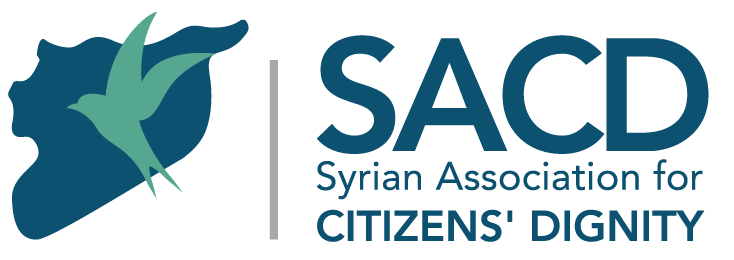Syrian Association for Citizens’ Dignity, in collaboration with the European Institute for Peace, recently hosted a high-level event on the margins of the Brussels VIII Conference on Syria. The event drew Syrian and international participants from across the globe to discuss the way forward on one of the key issues affecting Syrians – establishing a safe environment as a pre-requisite for any hope of a sustainable solution to the Syrian crisis.
The aim of the event was to address the increasingly confusing discourse on the meaning of safe environment in Syria, with various policy voices offering ad hoc and often partial interpretations of the concept of safe environment. Also, the event aimed to explore the current status of policy thinking on Syria in key countries – United States, Turkiye and the EU – regarding the political process and the creation of safe environment.
Envisioning a Safe Environment in Syria
The first panel was titled “SACD’s Roadmap: Envisioning a Safe Environment in Syria” and it gathered SACD representatives Dr. Talal Sunbulli, one of the co-founders of the Association, and Dr. Hala al Ghawi and Dr. Mazen Kseibi, Board members, as well as Dr. Samir Altaqi – General Director of the Orient Research Center.
The session focused on the SACD’s efforts to define a safe environment in accordance with the persistent needs and aspirations of a large majority of Syrians, primarily the displaced, through the seminal report “Roadmap to a Safe Environment in Syria” which was published in 2021 following several years of consultations and expert work.
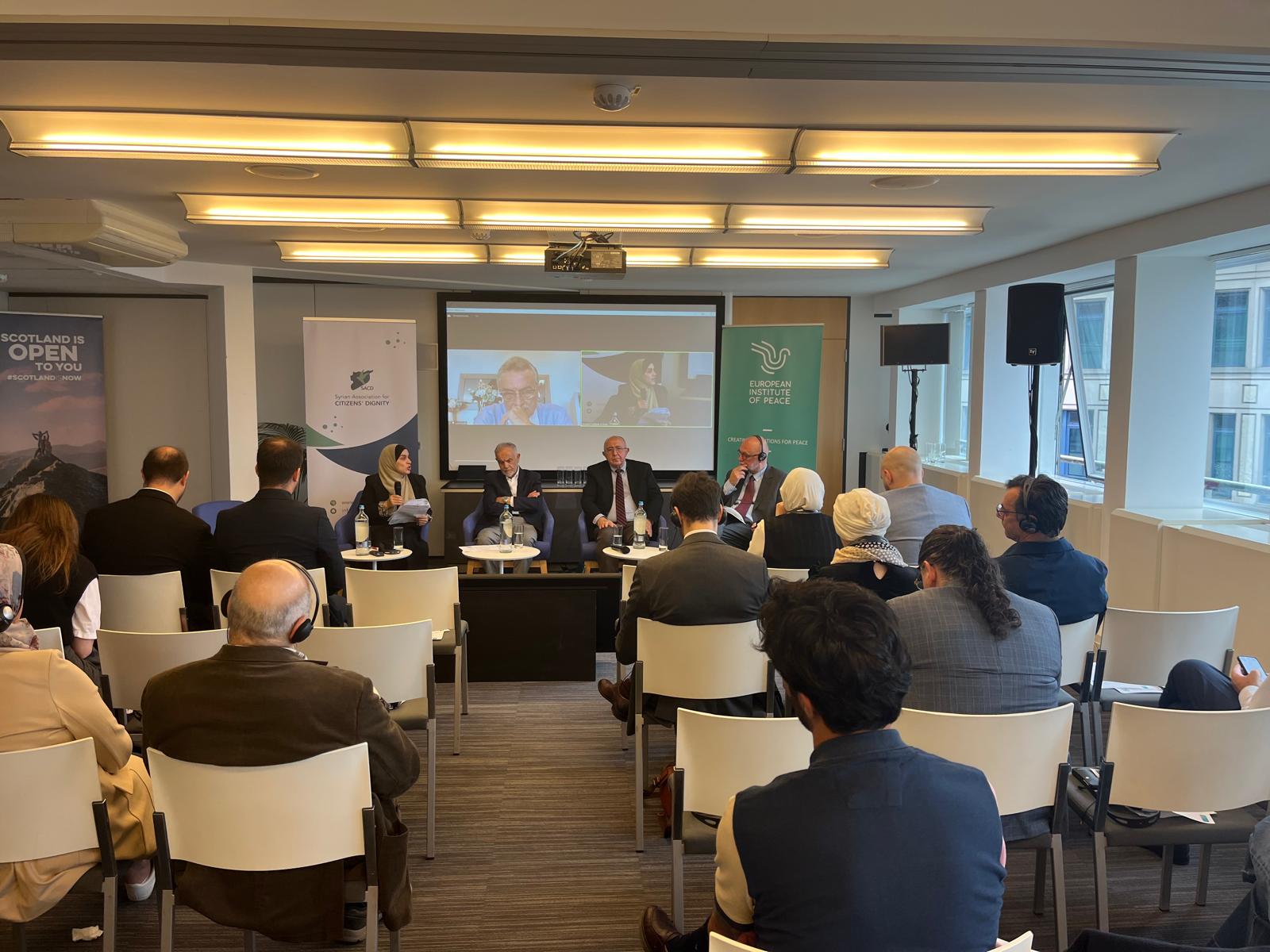
The session highlighted the urgent need to overcome the corrosive status quo of insecurity and the continued repressions, which is causing ongoing suffering of displaced Syrians in the north of the country, feeding the discontent of Syrians in areas such as Suwieda and Daraa, and preventing any conversation about the return of the displaced.
The initial conversation centered on SACD’s “Roadmap to a Safe Environment in Syria” and its phased approach to return, including pre-return, during return, and post-return phases. This phased approach has different prerequisites and objectives, and each lays the groundwork for the following phase, which has different work areas, actors, tools and results. Most importantly, each phase must gain the displaced Syrians’ confidence in the process, and demonstrate gradual yet tangible progress and a strong sense that guarantees by credible international actors are in place. The concept, however, is not limited only to the issue of return, but seeks to address the paralysis of the overall political process and as such seeks to achieve the following goals:
- Protect and promote the rights of Syrians and guarantee their security and interests regardless of any political considerations.
- Convey Syrians’ voice and vision regarding the issue of a safe environment—and how to achieve it.
- Present a practical way out of the current political paralysis by focusing on realistic steps to push the process forward, spearheaded by the conception and realisation of the safe environment. It is not realistic or practical to focus on individual components of the political solution, as they all rely on the implementation of a safe environment; yet the safe environment itself is being ignored.
- Propose practical confidence-building measures to restore Syrians’ confidence in the seriousness and commitment of the backers and guarantors of the political process, and their ability to achieve the conditions required for their return.
Dr Hala al Ghawi presented in detail the definition of the safe environment captured by the report and the various measures required to be implemented before any discussion about the safe, dignified and voluntary return can take place. Dr. al Ghawi emphasized that before any return can be considered, fundamental rights and freedoms must be established and guaranteed by international actors.
“The word ‘security’ in Syria is supposed to refer to the safety of citizens and an entity that looks after their well-being. Unfortunately, in Syria, this word is associated with security agencies that carry out serious violations harmful to Syrians. That’s why reforming the security sector is crucial and should be subject to international oversight if safe environment is to exist,” said Dr. al Ghawi. “The fears that Syrians have about returning to Syria are caused by several factors, but mainly they are related to security concerns. This includes arbitrary detention and the ongoing human rights violations occurring there.”
Dr. Mazen Kseibi provided an insight into the current reality facing a vast majority of Syrians in Syria, based the on “Fadinng Vision of s Safe Syria”, a far-reaching survey SACD conducted amongst some 3000 Syrians in regime-controlled areas of the country and AANES/SDF-controlled areas of north-east Syria to obtain a detailed understanding of how Syrians inside Syria feel about the issues affecting their lives—the economy and socio-economic deprivation, service provision and governance, security policies, detention and human rights, return, and the prospects for a political solution in Syria that can bring an end to the conflict, address root causes and provide a safe and dignified environment for the return of refugees and IDPs in the future. Accvording to Dr. Kseibi, the respondents’ answers highlight how damaging the current status quo has become. Syrians are poorer than ever and also more pessimistic about the future. Most of those surveyed who live in the regime-held areas have come to see the Syrian regime as a critical barrier to any form of positive change in the country, and that changes to the socio-economic, humanitarian and political situation in Syria cannot happen with the current political formation in place. Many have little faith in the UN-led political process but appear divided on what alternative future solutions might look like. With Syria displaying many of the signs of a failed state, more needs to be done to listen to the opinions of Syrians living face-to-face with the realities of the conflict.
“Seventy-five percent in regime-controlled areas and more than half in northeast Syria don’t feel safe and face threats to their security including arbitrary detention, forced conscription, and conflict-related violence,” said Dr. Kseibi. “Arbitrary detention came through as the biggest concern that Syrians face in regime-held areas despite regime propaganda in the media on amnesty decrees. For example, only 17% said they have relatives that have been released from detention under an amnesty decree recently.”
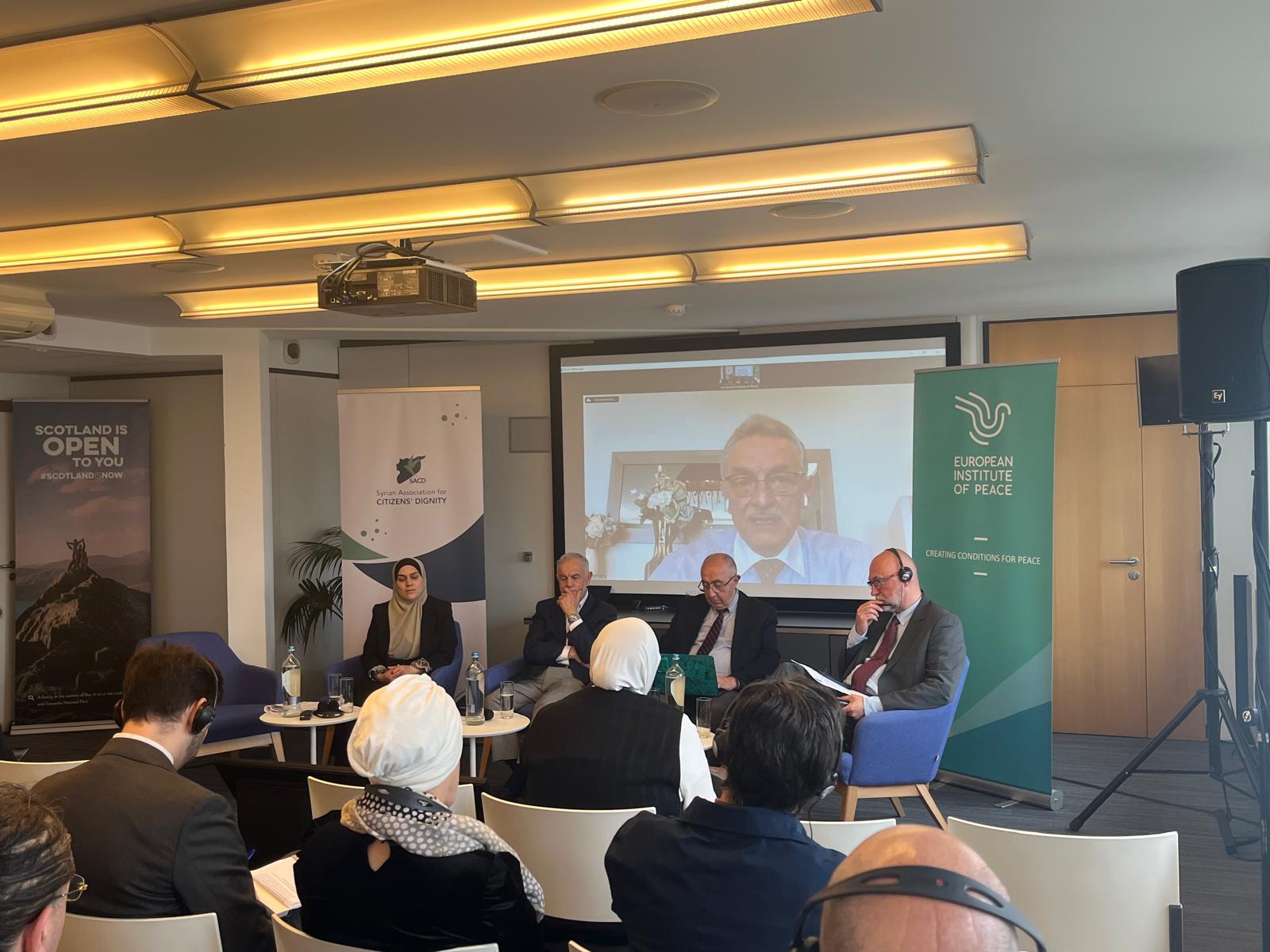
In describing how Syrians in diaspora view the current situation in Syria, Dr. Talal Sunbulli, one of the leaders of the Syrian community in the United States, echoed the findings presented by Dr. Kseibi. He emphasized that, despite the grandstanding of the Syrian regime about transitional justice, prisoner amnesties and the rest, the lack of any demonstrable and meaningful behaviour change by the regime, coupled with refugees’ and IDPs’ unwillingness to return home for the foreseeable future, means that the situation may reach a point of critical mass in the future whereby more Syrians are leaving the country—whether fleeing violence and persecution, instability, or poverty—than those returning. Stories from Libya of new generations of Syrian refugees, too young to remember the worst days of the conflict, boarding “death boats” in the Mediterranean points to the myriad risks that Syrians are willing to expose themselves and their families in search of a better life. “Syrians in Jordan and Lebanon don’t feel safe or secure to come back to Syria. They’d rather risk their lives to try and cross the ocean to the West by boat than to go back. We know what happens if you are forced to return. Syrian refugees who came back to Syria and tried to settle there, many of them have been persecuted, their belongings have been taken away, while many have simply been disappeared and we don’t know where they are.” Dr. Sunbulli had a simple message for those advocating for the so-called “economic safe environment”:
“For the last ten to twelve years, the Syrian regime has proven it cannot be trusted with finances. During earthquakes in northern Syria and south of Turkey, the money that was sent to the Syrian regime was distributed to regime-controlled areas, and areas inhabited by the so-called opposition did not receive anything. So even if you want to give money to the Syrian government, it’s not a solution. Looking at the issue as a financial one is not accurate or practical.”
Dr. Samir Altaqi posited several key questions to Syrians regarding the way forward from the current paralysis of the political process and possible developments on the horizon: Can we rise above hatred and division to save Syria from warlords and occupiers? Are we aware of the critical moment we face? Can we accept the diverse sects, races, and nationalities within our entity? He asserted that the window of opportunity is closing, and the alternative is fatal. It is time for Syrians to reclaim their country, their sovereignty, and their future.
“The sovereignty of the Syrian state has disintegrated, rendered meaningless by rampant corruption and military barriers. The economy is in shambles, with production cycles destroyed and black-market mafias plundering the country’s resources. The primary lifeline for many Syrians is now international aid from so-called “supporting states.”’ Said Dr. Altaqi. “Polls indicate that most Syrians believe the various de facto authorities are incapable of reconciliation, driving the country from bad to worse. This failure stands in stark contrast to our proud history, where unity among our founding fathers thwarted colonial attempts to divide us. Today, as regional dynamics shift, external actors once again attempt to manipulate Syrian factions, promoting a narrative of a benevolent colonizer. If the future of Syrians remains in the hands of foreign powers and their proxies, the cycle of violence and fragmentation will only deepen.”
Dr. Altaqi finished the session with the message that any solution imposed from outside, even if temporarily successful, is going to be ultimately disastrous.
“International and regional powers often claim that Syrians cannot coexist peacefully without their intervention. However, history and experience show that only Syrians can solve their own problems. The first step toward reclaiming our future is to resist the hijacking of the Syrian cause by external forces. These interveners suppress any possibility of national consensus and promote division. Syrians, both inside and outside the country, must reject this manipulation and work towards rebuilding civil society and national solidarity,” concluded Dr. Altaqi.
The Role of the International Actors in Syria’s Future
The second panel titled “Shaping Policy Priorities: The Role of the International Actors in Syria’s Future” explored strategies to influence the political process and key international actors such as Turkiye, U.S. and EU and their policies towards Syria. Ivan Nielsen, former Danish Special Representative for the Syria Crisis, Mohammed Alaa Ghanem, Policy Chief of the Syrian American Council and Ömer Özkizilcik, a non-residential fellow at the Atlantic Council discussed how international policy can be realigned to prioritize the safe return of Syrians, addressing the challenges of political paralysis.
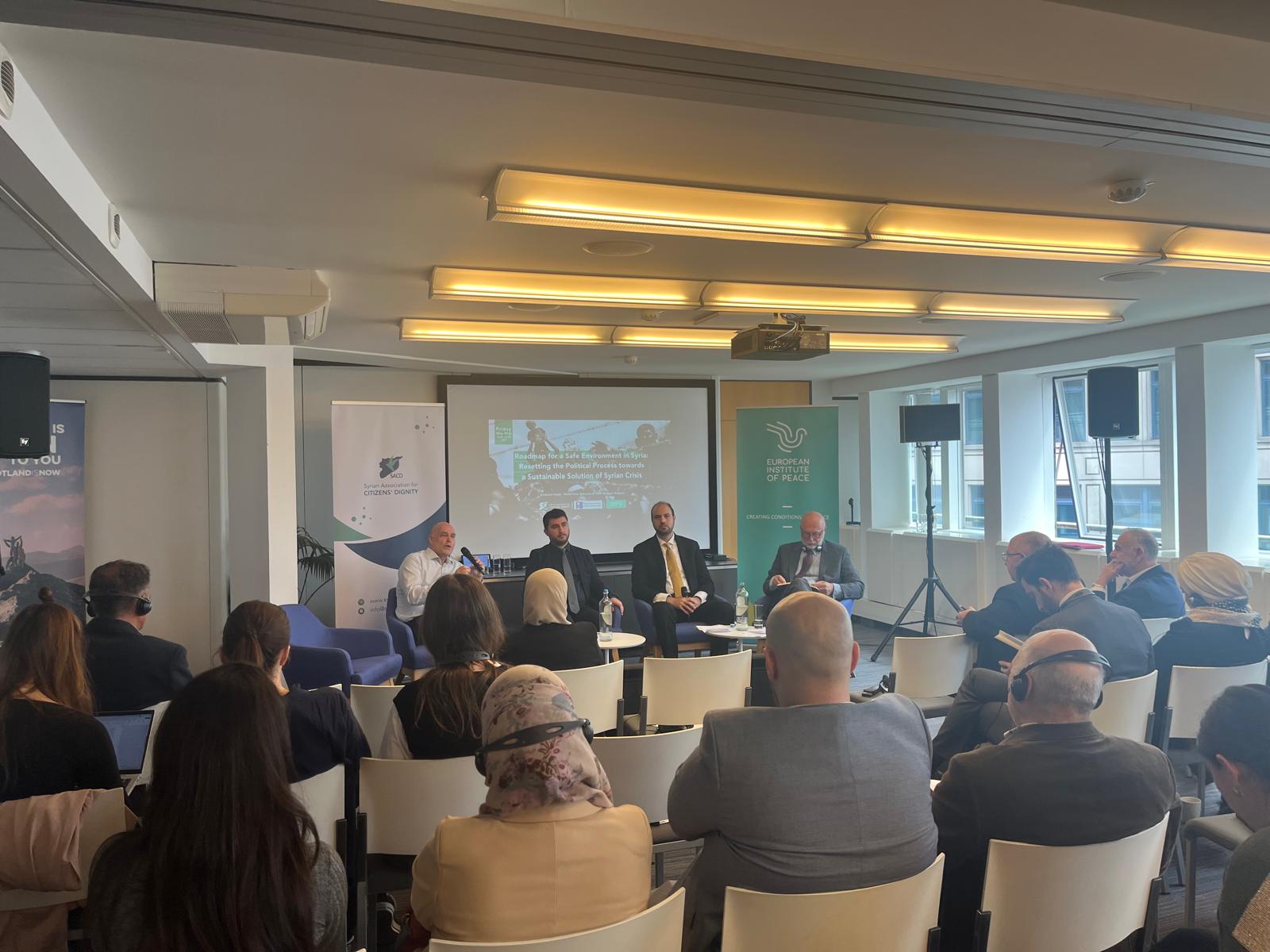
Mohammed Alaa Ghanem discussed the evolving U.S. stance on Syria. “Initially, the U.S. was adamant about not normalizing relations with the Syrian regime. And if you’re an ally of the United States, if you’re an Arab country, and you take steps towards normalization, we have sanctions on the books and you’re going to be liable. That changed. The U.S. position today seems to be ‘We’re not going to normalize ties with the regime. But should you make the sovereign decision to normalize ties with the regime, this is your business. And maybe while at it, maybe you can get something.” This shift reflects a broader trend of conflict management rather than resolution. Alaa Ghanem emphasized the belief that Syria is not a policy priority for the US or many in the international community but that the issues of the Syrian crisis will force itself on to policy agendas sue to the “spillover” effect. In his presentation, Alaa Ghanem described the efforts of the Syrian American community in gathering support for the passage of a number of bills on Syrian which have now passed through Congress – most recently the Assad Regime Anti-Normalization Act (H.R. 3202) – signalling that policy is gradually being formulated through the legislative action, solidifying an official bipartisan voice in DC on the Syrian crisis and ongoing issues. “American lawmakers from both parties, Democrats and Republicans, have gone on the record over six different times in the House and in the Senate, basically stating their opposition to this tolerance of normalization or tacit greenlight that was given to normalization and clearly expressing where they believe Syria policy should be headed.” Alaa Ghanem concluded with criticism of the Office of the Special Envoy, which, according to him, has recently advocated with American counterparts against the adoption of the Assad Anti-Normalization Bill.
“The work that we do is not because we simply just want to exact punishment on the regime…what we have in mind is building leverage for Syrian and American and European negotiators. The Office of the Special Envoy was created about ten years ago…they’ve been trying to produce any progress and they have not been able to because the regime has been very intransigent. So, in order to get any meaningful concessions from the regime, you need leverage…so we’re trying to build that leverage. And we’re saying concessions can be made, but in return for measurable progress, and we have not seen that yet.”
Full video of Mohammed Alaa Ghanem’s presentation
Ömer Özkizilcik provided insights into Turkey’s approach, marked by both pragmatism and frustration. “Turkey feels like the migration dump of Europe,” he said bluntly, pointing to the immense pressures on housing, infrastructure, and economic stability. Turkish attitude has advocated for engaging with and speaking to Damascus, this is why Turkey approached Damascus for conversations that ultimately failed, as it became clear that there were basic misconceptions about the goals of the Syrian regime. Özkizilcik maintained that the establishment of safe environment must be presented to Turkish policymakers as a step towards creating the possibility of return, rather than an obstacle, if it is to gain their support.
“If the safe environment topic could be articulated to Turkish decision makers as an avenue for Syrian refugees to return, they will be interested to listen. But if we are to create a safe environment, which is an issue that is an obstacle in front of refugee return, they won’t listen to this concept. The Turks are quite pragmatic. They don’t think conceptually according to definitions of a safe environment; they think according to the lines of housing, infrastructure, economy, and basic needs.”
Full video of Ömer Özkizilcik’s presentation
The last segment of the discussion focused on the position of European Union, which nominally maintains a firm stance against normalization with the Syrian regime, as reiterated by various speakers. However, stressed Ivan Nielsen, recent calls by some member states to reassess the return of refugees highlight ongoing tensions between humanitarian concerns and domestic political pressures. The discussions underscored the need for a unified, courageous approach that genuinely addressed the root causes of the Syrian crisis.
“There is a stated EU policy on Syria anchored in a very lengthy document called the European Council Conclusions from 2018. Basically, it can be summarized into the three no’s. And that is no to normalization, no to lifting sanctions, and no to reconstruction support before a political process, in line with 2254, is firmly underway. “Over time, sadly, we have seen that certain EU policymakers appear to be getting more itchy fingers in that they are less focused on the sticks and more focused on the carrots, even though from a simple analytical perspective, I think all of us would quickly agree that there will not work,” asserted Nielsen. He expressed worries that, as many actors on the international stage, the interests of member states regarding migration, refugees, and security concerns, led the EU policymakers to make the fundamental mistake of looking at the symptoms instead of the root causes “Policy is shying away from the right thing to do and also looking toward ad hoc policy approaches that really don’t serve European interests. Their policy approach is increasingly guided by providing some symptom relief.” Nielsen also stressed the importance of maintaining the proper definition of safe environment in policy conversations.
“The mention of “safe, calm and neutral environment” came about in the Geneva Communique as well as in UN Security Council Resolution 2254. And its origin was very simple. The premise was that a safe, calm, and neutral environment can only be brought about if there’s a new arrangement in Syria. It is not something that we can expect the current regime to bring about, so that’s very, very important to have in mind. So that’s why we insist that when we talk about SCNE, we confine it to track one, and 2254 and political solution, and not go down to track two or three or any other context.”
Full video of Ivan Nielsen’s presentation
Although it covered a broad spectrum of topics in a rich and layered discussion, the conference conclusion could be summed up in two clear messages when it comes to discussion on safe environment: 1.Support Syrian needs and solutions. 2. Stop sweeping the root causes of the Syrian crisis under the rug. One thing that this SACD-EIP event certainly managed to achieve was that Syrian voices were heard loud and clear at the heart of European policy making in Brussels.
Full video of the event:
